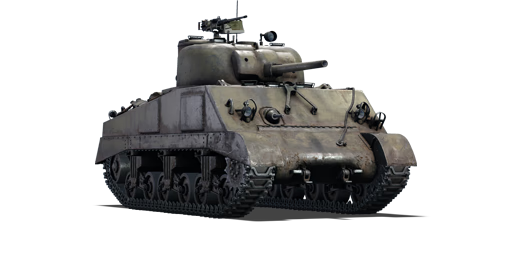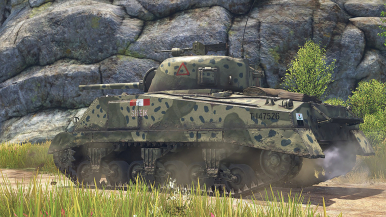The M4A2 Sherman is the third variant of the early-generation Medium Tank M4 (Sherman) family. In April 1942, the M4A2 was designed with a new General Motors 6046 engine (two GM 6-71 General Motors Diesel engines combined together), welded hull with increased appliqué armour on the hull sides, and gunner position (left side of the turret). Approximately 8,053 units were manufactured till May 1944. Early M4A2s had small hatches and protruding drivers' and co-drivers hoods (similar to the previous M4 variant), a 57° sloped hull's upper front armour plate, and dry ammo stowage bins. The Fisher Body Tank Plant later improved the M4A2 design, adding a one-piece hull's upper front armour plate with a 47° slope, but retained dry ammo bins and appliqué armour. Late-production M4A2s were equipped with an upgraded General Motors 6046 diesel engine with 410 horsepower and were primarily used by the British Army and US Marine Corps. The M4A2 variant saw very limited combat in the US Army, with the majority transferring to the British Army, with some transferring to the Soviet Army and the US Marine Corps. Since the USSR only used diesel-powered tanks, this was the primary chosen variant for the Soviet lend-lease programme. From April 1942 to July 1945, 10,968 units of all turret types were built in six facilities.
Introduced in Update 1.45 "Steel Generals", the M4A2 variant is without a doubt one of the best of the early-generation M4 Sherman variants. The M4A2 is one of the few early M4 Sherman variants having an uninterrupted, fully welded hull's upper front armour plate that slopes at 47°. This eliminates the earlier M4A1 and M4 variants' key frontal hull weak points. However, this is insignificant since the majority of adversaries have greatly upgraded their firepower and will easily penetrate the M4A2 regardless. The appliqué armour on the right side of the frontal turret gun mantlet has also been removed. As a result, a weak area on the turret cheek appears, which can be easily penetrated by even weak and small calibre tank guns.
















